Seung Hee Yang
Differential privacy for protecting patient data in speech disorder detection using deep learning
Sep 27, 2024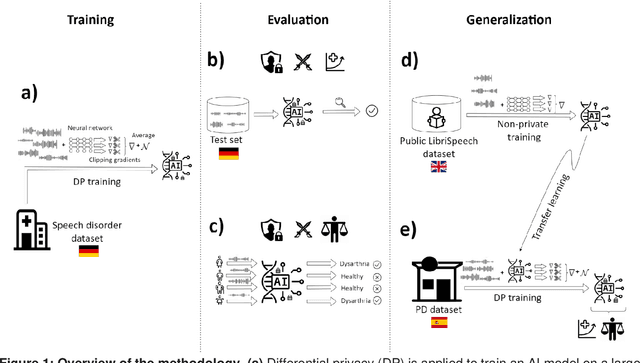
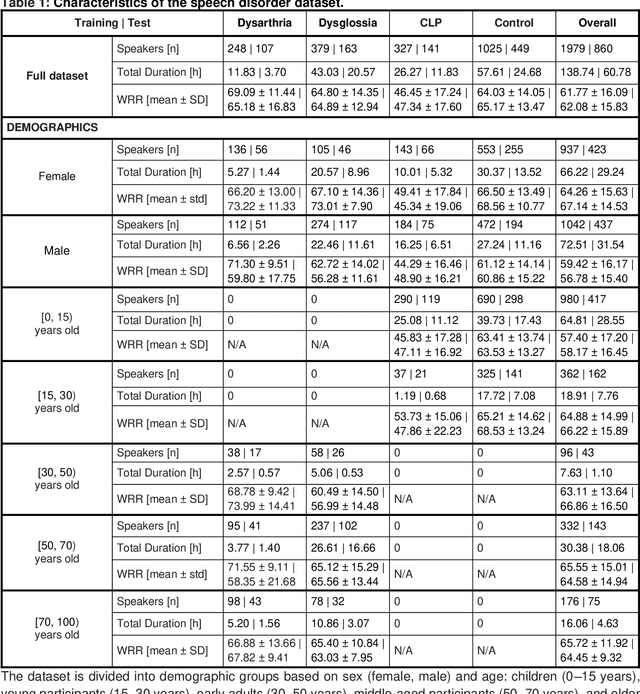
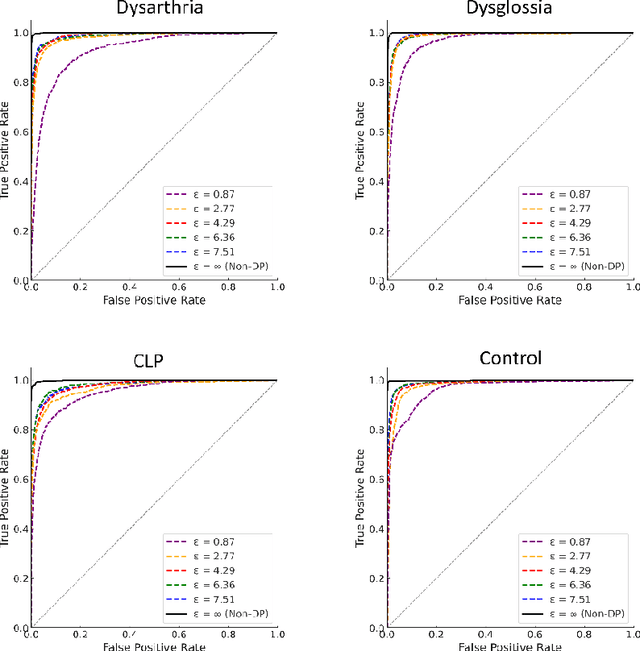
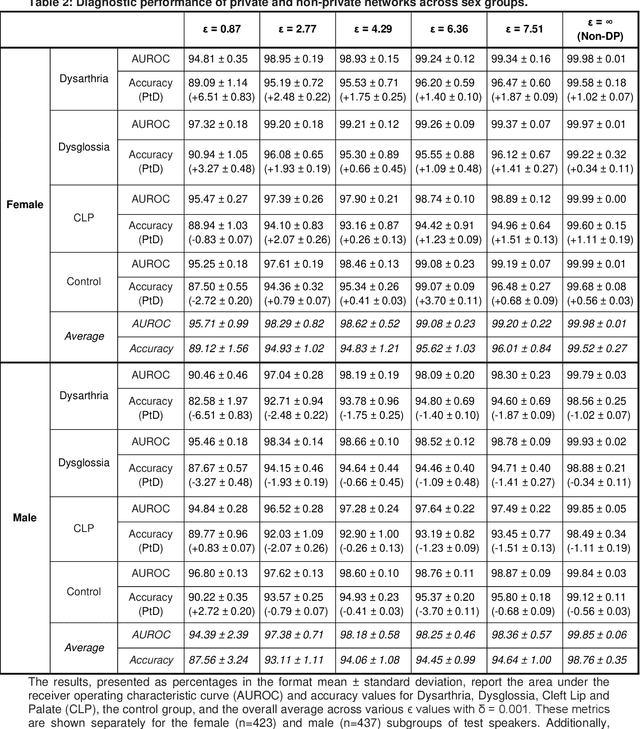
Abstract:Speech pathology has impacts on communication abilities and quality of life. While deep learning-based models have shown potential in diagnosing these disorders, the use of sensitive data raises critical privacy concerns. Although differential privacy (DP) has been explored in the medical imaging domain, its application in pathological speech analysis remains largely unexplored despite the equally critical privacy concerns. This study is the first to investigate DP's impact on pathological speech data, focusing on the trade-offs between privacy, diagnostic accuracy, and fairness. Using a large, real-world dataset of 200 hours of recordings from 2,839 German-speaking participants, we observed a maximum accuracy reduction of 3.85% when training with DP with a privacy budget, denoted by {\epsilon}, of 7.51. To generalize our findings, we validated our approach on a smaller dataset of Spanish-speaking Parkinson's disease patients, demonstrating that careful pretraining on large-scale task-specific datasets can maintain or even improve model accuracy under DP constraints. We also conducted a comprehensive fairness analysis, revealing that reasonable privacy levels (2<{\epsilon}<10) do not introduce significant gender bias, though age-related disparities may require further attention. Our results suggest that DP can effectively balance privacy and utility in speech disorder detection, but also highlight the unique challenges in the speech domain, particularly regarding the privacy-fairness trade-off. This provides a foundation for future work to refine DP methodologies and address fairness across diverse patient groups in real-world deployments.
Speaker- and Text-Independent Estimation of Articulatory Movements and Phoneme Alignments from Speech
Jul 03, 2024Abstract:This paper introduces a novel combination of two tasks, previously treated separately: acoustic-to-articulatory speech inversion (AAI) and phoneme-to-articulatory (PTA) motion estimation. We refer to this joint task as acoustic phoneme-to-articulatory speech inversion (APTAI) and explore two different approaches, both working speaker- and text-independently during inference. We use a multi-task learning setup, with the end-to-end goal of taking raw speech as input and estimating the corresponding articulatory movements, phoneme sequence, and phoneme alignment. While both proposed approaches share these same requirements, they differ in their way of achieving phoneme-related predictions: one is based on frame classification, the other on a two-staged training procedure and forced alignment. We reach competitive performance of 0.73 mean correlation for the AAI task and achieve up to approximately 87% frame overlap compared to a state-of-the-art text-dependent phoneme force aligner.
Towards Intelligent Speech Assistants in Operating Rooms: A Multimodal Model for Surgical Workflow Analysis
Jun 17, 2024



Abstract:To develop intelligent speech assistants and integrate them seamlessly with intra-operative decision-support frameworks, accurate and efficient surgical phase recognition is a prerequisite. In this study, we propose a multimodal framework based on Gated Multimodal Units (GMU) and Multi-Stage Temporal Convolutional Networks (MS-TCN) to recognize surgical phases of port-catheter placement operations. Our method merges speech and image models and uses them separately in different surgical phases. Based on the evaluation of 28 operations, we report a frame-wise accuracy of 92.65 $\pm$ 3.52% and an F1-score of 92.30 $\pm$ 3.82%. Our results show approximately 10% improvement in both metrics over previous work and validate the effectiveness of integrating multimodal data for the surgical phase recognition task. We further investigate the contribution of individual data channels by comparing mono-modal models with multimodal models.
The Impact of Speech Anonymization on Pathology and Its Limits
Apr 11, 2024Abstract:Integration of speech into healthcare has intensified privacy concerns due to its potential as a non-invasive biomarker containing individual biometric information. In response, speaker anonymization aims to conceal personally identifiable information while retaining crucial linguistic content. However, the application of anonymization techniques to pathological speech, a critical area where privacy is especially vital, has not been extensively examined. This study investigates anonymization's impact on pathological speech across over 2,700 speakers from multiple German institutions, focusing on privacy, pathological utility, and demographic fairness. We explore both training-based and signal processing-based anonymization methods, and document substantial privacy improvements across disorders-evidenced by equal error rate increases up to 1933%, with minimal overall impact on utility. Specific disorders such as Dysarthria, Dysphonia, and Cleft Lip and Palate experienced minimal utility changes, while Dysglossia showed slight improvements. Our findings underscore that the impact of anonymization varies substantially across different disorders. This necessitates disorder-specific anonymization strategies to optimally balance privacy with diagnostic utility. Additionally, our fairness analysis revealed consistent anonymization effects across most of the demographics. This study demonstrates the effectiveness of anonymization in pathological speech for enhancing privacy, while also highlighting the importance of customized approaches to account for inversion attacks.
Federated learning for secure development of AI models for Parkinson's disease detection using speech from different languages
May 18, 2023Abstract:Parkinson's disease (PD) is a neurological disorder impacting a person's speech. Among automatic PD assessment methods, deep learning models have gained particular interest. Recently, the community has explored cross-pathology and cross-language models which can improve diagnostic accuracy even further. However, strict patient data privacy regulations largely prevent institutions from sharing patient speech data with each other. In this paper, we employ federated learning (FL) for PD detection using speech signals from 3 real-world language corpora of German, Spanish, and Czech, each from a separate institution. Our results indicate that the FL model outperforms all the local models in terms of diagnostic accuracy, while not performing very differently from the model based on centrally combined training sets, with the advantage of not requiring any data sharing among collaborators. This will simplify inter-institutional collaborations, resulting in enhancement of patient outcomes.
PoCaP Corpus: A Multimodal Dataset for Smart Operating Room Speech Assistant using Interventional Radiology Workflow Analysis
Jun 24, 2022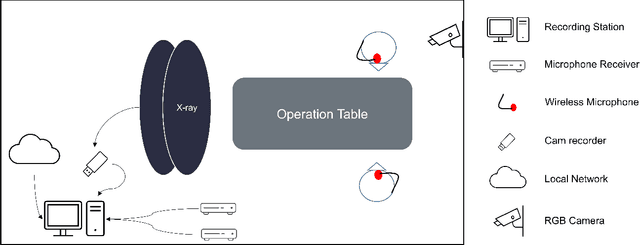
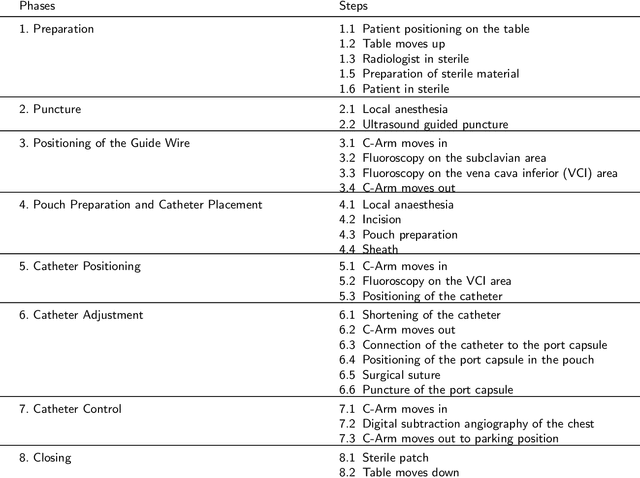
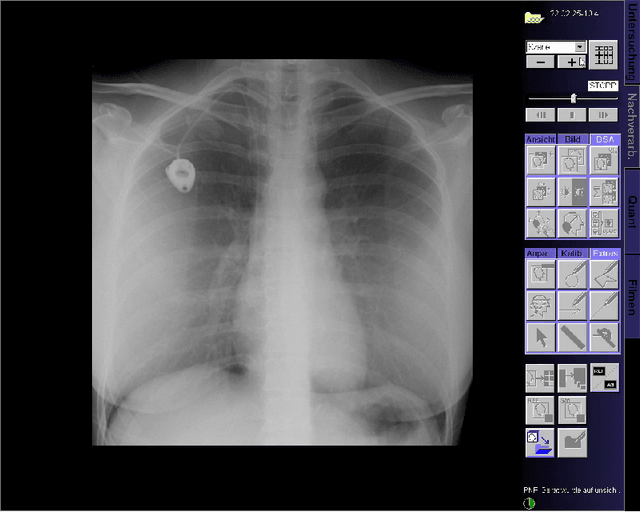
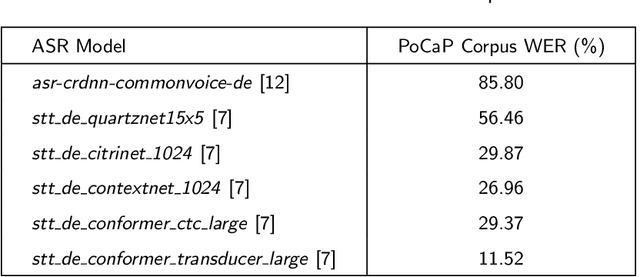
Abstract:This paper presents a new multimodal interventional radiology dataset, called PoCaP (Port Catheter Placement) Corpus. This corpus consists of speech and audio signals in German, X-ray images, and system commands collected from 31 PoCaP interventions by six surgeons with average duration of 81.4 $\pm$ 41.0 minutes. The corpus aims to provide a resource for developing a smart speech assistant in operating rooms. In particular, it may be used to develop a speech controlled system that enables surgeons to control the operation parameters such as C-arm movements and table positions. In order to record the dataset, we acquired consent by the institutional review board and workers council in the University Hospital Erlangen and by the patients for data privacy. We describe the recording set-up, data structure, workflow and preprocessing steps, and report the first PoCaP Corpus speech recognition analysis results with 11.52 $\%$ word error rate using pretrained models. The findings suggest that the data has the potential to build a robust command recognition system and will allow the development of a novel intervention support systems using speech and image processing in the medical domain.
Is Speech Pathology a Biomarker in Automatic Speaker Verification?
Apr 13, 2022



Abstract:With the advancements in deep learning (DL) and an increasing interest in data-driven speech processing methods, a major challenge for speech data scientists in the healthcare domain is the anonymization of pathological speech, which is a required step to be able to make them accessible as a public training resource. In this paper, we investigate pathological speech data and compare their speaker verifiability with that of healthy individuals. We utilize a large pathological speech corpus of more than 2,000 test subjects with various speech and voice disorders from different ages and apply DL-based automatic speaker verification (ASV) techniques. As a result, we obtained a mean equal error rate (EER) of 0.86% with a standard deviation of 0.16%, which is a factor of three lower than comparable healthy speech databases. We further perform detailed analyses of external influencing factors on ASV such as age, pathology, recording environment, and utterance length, to explore their respective effect. Our findings indicate that speech pathology is a potential biomarker in ASV. This is potentially of high interest for the anonymization of pathological speech data.
Disentangled Latent Speech Representation for Automatic Pathological Intelligibility Assessment
Apr 08, 2022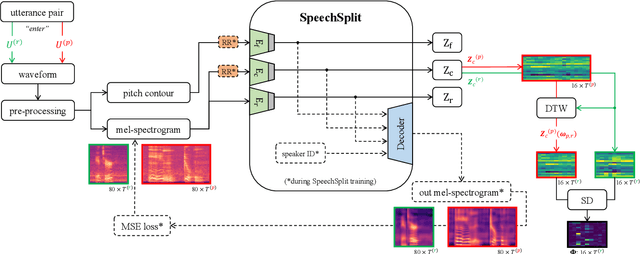
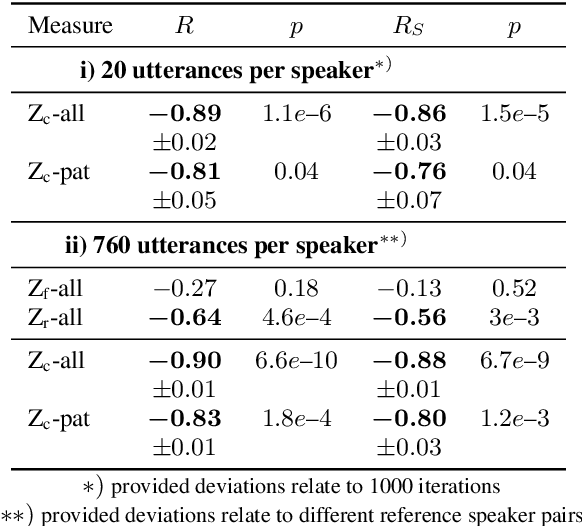
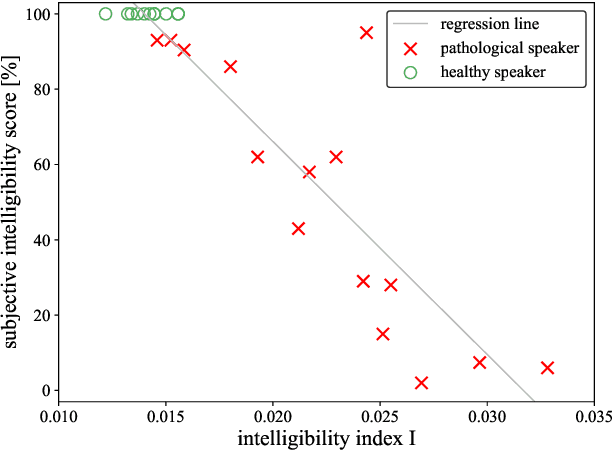
Abstract:Speech intelligibility assessment plays an important role in the therapy of patients suffering from pathological speech disorders. Automatic and objective measures are desirable to assist therapists in their traditionally subjective and labor-intensive assessments. In this work, we investigate a novel approach for obtaining such a measure using the divergence in disentangled latent speech representations of a parallel utterance pair, obtained from a healthy reference and a pathological speaker. Experiments on an English database of Cerebral Palsy patients, using all available utterances per speaker, show high and significant correlation values (R = -0.9) with subjective intelligibility measures, while having only minimal deviation (+-0.01) across four different reference speaker pairs. We also demonstrate the robustness of the proposed method (R = -0.89 deviating +-0.02 over 1000 iterations) by considering a significantly smaller amount of utterances per speaker. Our results are among the first to show that disentangled speech representations can be used for automatic pathological speech intelligibility assessment, resulting in a reference speaker pair invariant method, applicable in scenarios with only few utterances available.
Self-Supervised Speech Representations Preserve Speech Characteristics while Anonymizing Voices
Apr 04, 2022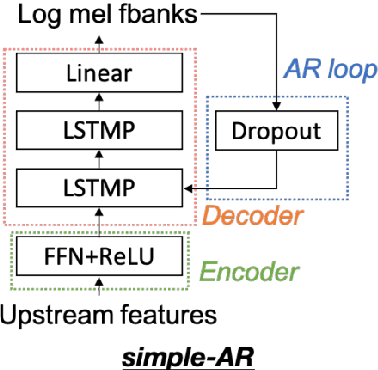
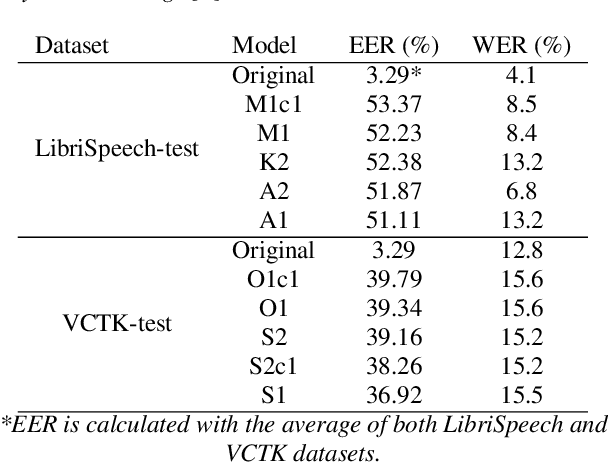

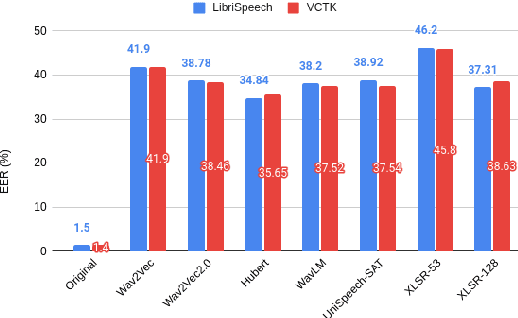
Abstract:Collecting speech data is an important step in training speech recognition systems and other speech-based machine learning models. However, the issue of privacy protection is an increasing concern that must be addressed. The current study investigates the use of voice conversion as a method for anonymizing voices. In particular, we train several voice conversion models using self-supervised speech representations including Wav2Vec2.0, Hubert and UniSpeech. Converted voices retain a low word error rate within 1% of the original voice. Equal error rate increases from 1.52% to 46.24% on the LibriSpeech test set and from 3.75% to 45.84% on speakers from the VCTK corpus which signifies degraded performance on speaker verification. Lastly, we conduct experiments on dysarthric speech data to show that speech features relevant to articulation, prosody, phonation and phonology can be extracted from anonymized voices for discriminating between healthy and pathological speech.
Cross-lingual Self-Supervised Speech Representations for Improved Dysarthric Speech Recognition
Apr 04, 2022



Abstract:State-of-the-art automatic speech recognition (ASR) systems perform well on healthy speech. However, the performance on impaired speech still remains an issue. The current study explores the usefulness of using Wav2Vec self-supervised speech representations as features for training an ASR system for dysarthric speech. Dysarthric speech recognition is particularly difficult as several aspects of speech such as articulation, prosody and phonation can be impaired. Specifically, we train an acoustic model with features extracted from Wav2Vec, Hubert, and the cross-lingual XLSR model. Results suggest that speech representations pretrained on large unlabelled data can improve word error rate (WER) performance. In particular, features from the multilingual model led to lower WERs than filterbanks (Fbank) or models trained on a single language. Improvements were observed in English speakers with cerebral palsy caused dysarthria (UASpeech corpus), Spanish speakers with Parkinsonian dysarthria (PC-GITA corpus) and Italian speakers with paralysis-based dysarthria (EasyCall corpus). Compared to using Fbank features, XLSR-based features reduced WERs by 6.8%, 22.0%, and 7.0% for the UASpeech, PC-GITA, and EasyCall corpus, respectively.
 Add to Chrome
Add to Chrome Add to Firefox
Add to Firefox Add to Edge
Add to Edge